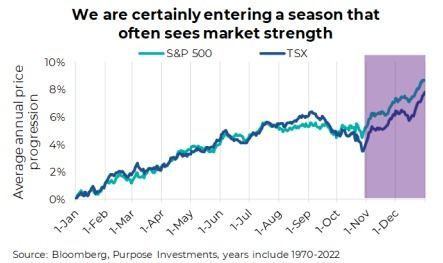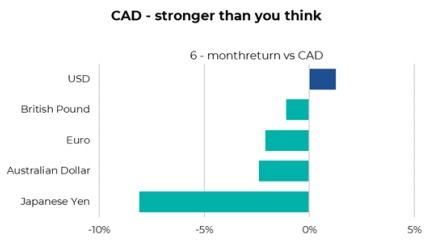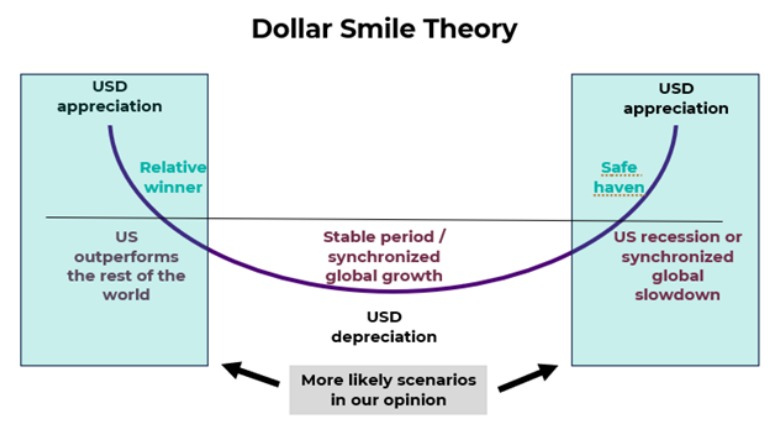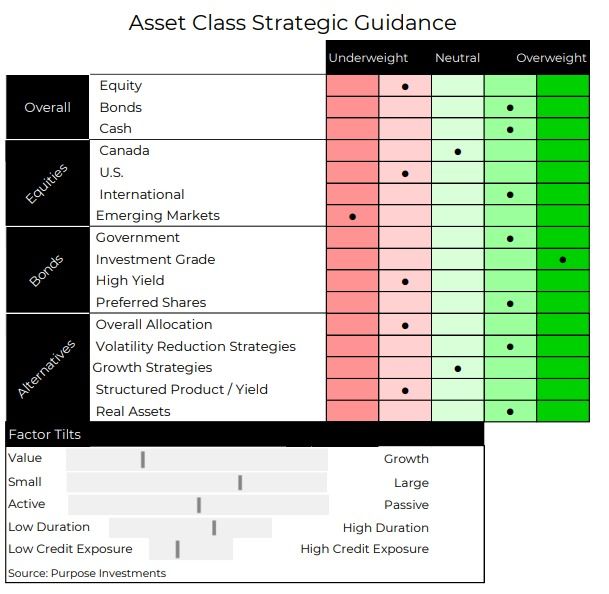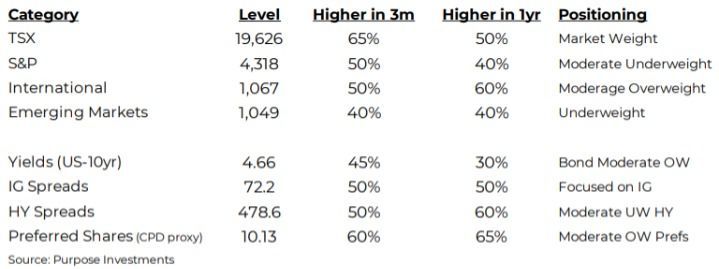2022 was certainly a rather painful year for investing.
There were more central bank rate hikes than any of us would care to count, yields moved from ultra lows to the highest in a few decades, and markets took it on the chin. Worse yet, everything moved together as both equities and bonds fell. Sadly, that is what happens when rates, or the discount rate, go from near zero to 5%. As usual, the market went too far, and a bottom was put in about a year ago in October, after which a decent rally ensued.
And that’s the way it's supposed to work, right? If investor memory is limited to the last few years or even the last two decades, any material sell-off is “always” followed by a recovery, which then goes even further to make new highs. That mindset was further cemented in 2020. Sadly, if you have a long memory, you may well realize this is not the norm. We are likely in a repricing of everything environment. After more than a decade of too much capital floating around, costing too little (aka low yields), and being used for perhaps non-economical endeavours, the reversal is now on. And the reversal will likely be a long process, longer than a few months or a few quarters. Which we believe ends in a recession.
Fortunately, nothing moves in a straight line, and that is certainly the case for markets. The market rally over the past twelve months that peaked at the end of July was very impressive. This was followed by declines from August through October, a seasonally weak period. The main culprit was rising bond yields, not due to inflation concerns like in 2022, but instead due to a strong U.S. economy and the very aggressive issuance of U.S. Treasury bonds into a market that has some historically resilience buyers not as enthusiastic.
The good news is the strong issuance is slowing for now as the general account has been largely replenished after being bled dry during the debt ceiling self-induced stress. And economic growth, even for the mighty U.S. economy, is slowing. This has bond yields coming back down, which could very easily set the stage for a pleasant year-end rally, which may have already gotten started.
Bonds – We don’t believe the market needed to hear the Fed indicate they are likely done. If more people bothered to look at the recent data, some cracks are increasingly showing up in the economy and the trajectory of inflation data, all of which the Fed certainly looks at – they ought to be done and may have already gone too far. That is good news for bonds; the chart below is the 10-year yield before and after the Fed stops hiking. The path is predominantly lower; yay, bonds up.
Stocks – We’re not big fans of seasonality, but we certainly are aware of it and the evidence behind it. The fact is, year-end rallies happen more often than not, and those gains can be impactful. Perhaps that has already started as the market, measured by global equities, had fallen 11% from August 1 through the end of October but has not ‘bounced’ 4%. Earnings season is over, company share buy-back blackouts are largely over, sentiment has turned rather negative (AAII is 50% bearish, 24% bullish), markets are oversold (less so after the past week), one could easily argue the table is set for a year-end rally.
The data doesn’t lie, and the above chart is rather compelling for both the S&P and TSX. But we would temper this with the knowledge that averages often hide more than they reveal. Yes, over the past 50-some-odd years, the average price gain for the TSX and S&P has been positive and stronger than other periods. However, that range of performance goes from +13% to -10%, and it was positive about 2/3rds of the time, conversely negative the other 1/3. So the chart looks great, but there remain many outcomes.
Still, seasonality is an incremental positive. We remain in the same camp as before. We believe inflation is cooling and will fade as a near-term issue (likely to return in future years). The recent move higher in yields was driven in part by a strong U.S. economy, partly thanks to QE being turned back on temporarily back in March and a very healthy or resilient consumer. Getting so tired of the word “resilient.” The higher yields were also a short-term supply/demand issue, which is starting to fade (again, for now). Pile it all up, and yields should cool, and we may have seen peak yields.
Falling yields will help the equity market move higher. Yes, bonds and equities are moving in the same direction, up this time, so I highly doubt anyone will complain. How far it could go is challenging as next year is quickly becoming the problem. 2024 recession risk is high. Corporate margin risk is high. We are renters of a year-end rally.
Who yields first?
Despite recent noteworthy moves in the currency markets, overall volatility measured by the Deutsche Bank FX Volatility Indicator remains rather subdued. Japan has been in the news, with the Yen falling to near a 33- year low after the recent Bank of Japan’s policy move. Besides that, the moves in FX land have been more plodding along and less spirited compared to certain periods over the past few years. Global rates being higher for longer is sure to ramp up some financial drama. Higher rates have this ability to expose weaker players both at a company as well as at a country level.
This is the primary reason why the Canadian dollar has slid against the U.S. dollar over the past four months. Declining as much as 5.8%. Quite the move in currency land. Surprisingly, the Canadian dollar has shown more resilience against other currencies than it might seem. In the chart below, we plot the loonie’s returns against several other key currencies over the past six months, and it’s actually held up rather well, outperforming the Pound, Euro, Aussie dollar and the Yen. So no, the loonie isn’t in peril, but Canada does face a number of challenges.
Whether it’s credit losses, liquidity crunches, or simply exposing high leverage and weak hands, tighter financial conditions can impact countries just as much as companies. This would explain the swift shift in sentiment for the Canadian dollar in both futures as well as spot markets.
The critical question is which central banks will yield first. Both the Fed and BoC have expressed caution, saying it’s too early to wave the victory flag after their battle with inflation. While both have moved in tandem over the past year and a half, Canada was the first to pause and may be the first to cut. The market is making its bets, but such big shifts are inherently unpredictable.
The surprisingly resilient economy south of our border in recent months has helped push the U.S. dollar higher. Mounting recession fears and lower growth expectations across Europe as well as in Canada have pushed these currencies lower. Nonetheless, the market is still pricing in more rate cuts for the Federal Reserve than other major central banks despite the reality of a more resilient U.S. economy. This is highly incongruous. If the Fed is indeed cutting, we believe others, such as the BoC, will be cutting first.
Key drivers of the CAD-USD relationship remain economic factors, commodity prices, market sentiment and monetary policy. These factors manifest in the bond market. In the chart below, we can see that despite oil moving higher since the summer, rate differentials have trended lower, placing the Canadian dollar at the lower end of a year-long range. Previously, this would be an area that might have prompted the consideration of partial hedges. However, we continue to hold a near-term positive view of the USD due to several factors. Rate differentials make the U.S. a relatively attractive destination for investment. This favours the USD. The spread – or gap – between the yield on benchmark Canadian and U.S. debt was 42bps this week, the highest level since the spring. To think that in June, the spread had all but evaporated.
The graph below illustrates the market’s growing dovish expectations of the BoC growing over the past few months. The implied March 2024 central bank rate for the U.S. and Canada was nearly equal in the summer; however, the market is pricing in a 32bps difference within the next four months, suggesting that the BoC will act first.
The Dollar Smile Theory, although somewhat theoretical, remains a core currency concept. The graphic below is a simplified version that outlines three broad scenarios for the dollar and everything else. A stronger dollar occurs when the US is the big relative winner versus everyone else in terms of growth. This is pure American exceptionalism. The other side is when the dollar benefits from a global downturn, sparking safe-haven demand for the U.S. currency. Two opposite ends of the spectrum, but both result in a strong dollar. The dip in the middle is when the dollar is weaker, indicating global economic stability or synchronized growth. Given these scenarios, our base case remains a looming recession. It could be global but possibly less synchronized. In either case, we believe the more likely scenarios will result in sustained dollar demand.
Our outlook for the CAD is more cautious, with a downside bias. Although, near-term, we could see a technical bounce from oversold levels, there remain several major factors that present risks. Chief among them is the potential that Canada is likely to experience a deeper economic slowdown. Though fluctuation in commodity prices may have an impact in the near future, we don’t see the recent strength in the energy market to provide enough of an updraft for the loonie to fly. For now, we prefer unhedged U.S. exposure, believing the Bank of Canada will maintain a relatively dovish stance compared to the Federal Reserve, which will weigh on the Canadian dollar.
Market Cycle, Positioning, Probabilities
There is some good news out there, and that good news is things have gotten a little worse. Yes, we are all living and investing in the upside-down (thankfully, no Demogorgon for those Stranger Things fans). It is upside down because signs of weakening economic data is a good thing. It further alleviates inflation concerns, which we believe will continue to fade. The weaker data also helps bring those bond yields back down a bit, and given much of the equity market weakness over the past few months was largely caused by higher yields, weaker data equals good news…..for now.
And the data is getting weaker. Yes, we have all heard how resilient the U.S. economy is, and it did just post a 4.9% annualized rate for Q3. We would also point out that everyone had come around to seeing the U.S. economy really took a step up in the summer, which is embedded in that GDP print. More recently, though, the strength appears to be oscillating back to weakness. The October U.S. labour report was a miss. We are also seeing further weakness in a number of our Market Cycle Indicators.
Three Market Cycle indicators for the broader U.S. economy flipped to bearish. GDP Now from the Atlanta Fed dropped. This GDP measure doesn’t track GDP but instead uses a number of more timely inputs to gauge how the economy is doing, ‘today.’ After all, the official GDP, which was just released in late October, tells you how the economy was doing all the way back in July, August and September. Consumer sentiment also dropped, and unemployment ticked higher. The unemployment one is a big deal; it has risen to 3.9%. This may sound inconsequential, but unemployment is now +0.5% from its cycle low of 3.4% back in March. A half percent move in unemployment has been a very reliable early indication of a recession.
Add a drop in housing starts that flipped from bullish to bearish, and the drop in all the indicators came from America. Our belief is the economy is slowing, more outside North America, but it's coming back closer to home now, too. The U.S. enjoyed a positive economic growth bounce in the middle of this year, which everyone jokingly attributes to the Barbie movie and Taylor Swift. But now, with the movie fading and Taylor focused on the Chiefs, things are slowing down. Ok, now I’m really kidding. More likely, quantitative easing was turned back on in the spring to help out U.S. banks. This likely injected capital, suppressed yields and led to this uptick in growth. Whatever the cause you prefer, we believe growth will fade into 2024.
Portfolio Positioning
In terms of portfolio positioning, we did add a bit to bonds when yields spiked higher. So clearly happy to see them coming back down a bit. This change increased our government and duration a little, as we used cash to fund the change. In equities, we prefer safer vehicles with an affinity toward dividend-yielding shares, which we view as attractive value. We remain overweight international. Within the fixed income space, we prefer the safety of investment grade bonds and government debt, believing the risk/reward trade-off in the high yield space is not yet tilted in the investor's favour. Despite the continued sell-off in emerging market shares, we’ve yet to even dip our toe into this asset class. Within alternatives, we prefer real assets and defensive strategies.
Probabilities
Markets have come down in August, September and October as bond yields have risen (aka bond prices down). Things certainly became oversold on a short-term basis, and we believe the bounce has started. We slightly increased our probability of equity markets moving higher in the next three months. However, longer-term views have not moved.
The table below is a synopsis of some of our behind-the-scenes debates, analyses, and even arguments. We hope this provides some added insight into our process but also into our conviction on current positioning. This will become a standard component of future updates so we can all monitor changing views, opinions and, of course, positioning. If you would like to compare it with last month's (HERE) – but really, as mentioned, there are just minor changes from that edition.
The Final Word
Markets and the economy are gradually adjusting to higher costs of capital (higher yields/rates) and less abundant capital. The process will take a long time to work its way through, causing both up and down oscillations in the stock and bond markets. This will also likely lead to a recession that may not be as soft as the consensus believes. This does have us still leaning with a moderately defense stance in our multi-asset portfolios. But still with enough exposure to benefit from a potential rally into year-end. If this does transpire, we would anticipate getting a bit more defensive on strength.
Year-end rally or not, hard, soft or no landing, either way, markets are making progress and steadily getting closer to being in a much better place to start the next cycle.
— Craig Basinger is the Chief Market Strategist at Purpose Investments
— Derek Benedet is a Portfolio Manager at Purpose Investments
— Brett Gustafson is an Analyst at Purpose Investments
Source: Charts are sourced to Bloomberg L.P. and Purpose Investments Inc.
The contents of this publication were researched, written and produced by Purpose Investments Inc. and are used by Echelon Wealth Partners Inc. for information purposes only.
This report is is authored by Craig Basinger, Greg Taylor and Derek Benedet Purpose Investments Inc.
Disclaimers
Echelon Wealth Partners Inc.
The opinions expressed in this report are the opinions of the author and readers should not assume they reflect the opinions or recommendations of Echelon Wealth Partners Inc. or its affiliates. Assumptions, opinions and estimates constitute the author's judgment as of the date of this material and are subject to change without notice. We do not warrant the completeness or accuracy of this material, and it should not be relied upon as such. Before acting on any recommendation, you should consider whether it is suitable for your particular circumstances and, if necessary, seek professional advice. Past performance is not indicative of future results. The comments contained herein are general in nature and are not intended to be, nor should be construed to be, legal or tax advice to any particular individual. Accordingly, individuals should consult their own legal or tax advisors for advice with respect to the tax consequences to them.
Purpose Investments Inc.
Purpose Investments Inc. is a registered securities entity. Commissions, trailing commissions, management fees and expenses all may be associated with investment funds. Please read the prospectus before investing. If the securities are purchased or sold on a stock exchange, you may pay more or receive less than the current net asset value. Investment funds are not guaranteed, their values change frequently and past performance may not be repeated.
Forward Looking Statements
Forward-looking statements are based on current expectations, estimates, forecasts and projections based on beliefs and assumptions made by author. These statements involve risks and uncertainties and are not guarantees of future performance or results and no assurance can be given that these estimates and expectations will prove to have been correct, and actual outcomes and results may differ materially from what is expressed, implied or projected in such forward-looking statements. Assumptions, opinions and estimates constitute the author’s judgment as of the date of this material and are subject to change without notice. Neither Purpose Investments nor Echelon Partners warrant the completeness or accuracy of this material, and it should not be relied upon as such. Before acting on any recommendation, you should consider whether it is suitable for your particular circumstances and, if necessary, seek professional advice. Past performance is not indicative of future results. These estimates and expectations involve risks and uncertainties and are not guarantees of future performance or results and no assurance can be given that these estimates and expectations will prove to have been correct, and actual outcomes and results may differ materially from what is expressed, implied or projected in such forward-looking statements. Unless required by applicable law, it is not undertaken, and specifically disclaimed, that there is any intention or obligation to update or revise the forward-looking statements, whether as a result of new information, future events or otherwise. Before acting on any recommendation, you should consider whether it is suitable for your particular circumstances and, if necessary, seek professional
advice.
The particulars contained herein were obtained from sources which we believe are reliable, but are not guaranteed by us and may be incomplete. This is not an official publication or research report of either Echelon Partners or Purpose Investments, and this is not to be used as a solicitation in any jurisdiction.
This document is not for public distribution, is for informational purposes only, and is not being delivered to you in the context of an offering of any securities, nor is it a recommendation or solicitation to buy, hold or sell any security.



